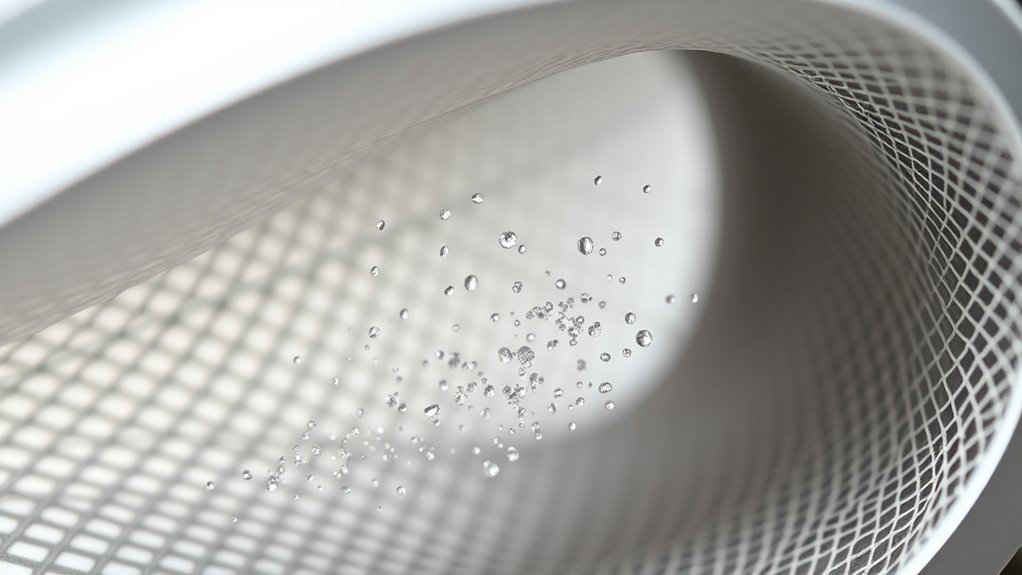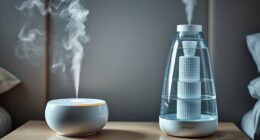HEPA filters remove allergens through multiple mechanisms, including sieving, impaction, interception, and diffusion, each targeting particles of different sizes. Larger particles like pollen and dust are trapped mainly through sieving and impaction, while ultrafine particles like viruses are captured by diffusion with Brownian motion. The critical 0.3-micron size marks the most challenging particles, but HEPA filters excel at capturing them all. To understand how these processes work together, keep exploring the details.
Key Takeaways
- HEPA filters use multiple mechanisms—sieving, impaction, interception, and diffusion—to capture a wide range of allergen particle sizes.
- Diffusion effectively traps ultrafine allergens like viruses and microscopic pollutants by Brownian motion.
- Particles around 0.3 microns, including many allergens, are targeted through a combination of diffusion and interception.
- Proper filter design, material density, and electrostatic properties enhance allergen removal efficiency across different particle sizes.
- Regular maintenance and environmental monitoring ensure sustained filtration performance and high allergen removal effectiveness.
The Principles Behind Particulate Capture in HEPA Filters

HEPA filters remove particles through four main mechanisms: sieving, inertial impaction, interception, and diffusion. Sieving traps larger particles, typically over 10 microns, by physically blocking their passage through filter fibers. Inertial impaction captures particles between 1 and 10 microns by causing them to collide with fibers due to their inertia when airflow changes direction. Interception occurs when particles around 0.3 to 1 micron follow airflow lines closely and contact fibers, getting trapped without impacting directly. Diffusion is effective for very small particles, including viruses and sub-micron dust, by random Brownian motion increasing their chances of contact with filter fibers. These capture mechanisms work together, targeting different particle sizes to ensure thorough filtration.
How Sieving, Interception, and Impaction Contribute to Filtration

You should understand how different mechanisms work together to trap particles of various sizes. Sieving blocks larger particles, while interception catches smaller ones that follow airflow lines. Impaction then captures mid-sized particles by forcing them to collide with filter fibers. Additionally, filter material design plays a crucial role in optimizing these filtration processes for maximum efficiency. The particle size distribution significantly influences how well each mechanism performs under different conditions. The choice of filter media can significantly influence how effectively these mechanisms perform under different conditions. Furthermore, advancements in HEPA filter technology have enhanced the ability of filters to trap even the tiniest particles, further improving air purification effectiveness. As a result, ongoing research continues to develop innovative filtration materials that boost overall performance.
Particle Size Capture
How do HEPA filters manage to trap such a wide range of airborne particles? It’s all about particle size capture, where different mechanisms target particles of various sizes. Larger particles over 0.3 microns are removed through sieving, which blocks them directly. Interception occurs when particles following airflow paths come within one particle radius of filter fibers, causing them to stick. Inertial impaction affects larger particles that can’t follow curved airflow lines, colliding with fibers and sticking. For smaller particles, diffusion plays a key role, as Brownian motion increases their chances of contact with filter fibers. Additionally, filter material properties significantly influence the efficiency of these processes. The density and fiber arrangement of the filter material also impact how effectively these mechanisms operate, especially in capturing very fine particles. Moreover, the porosity of the filter determines how easily air can pass through while maintaining high filtration efficiency. Incorporating fiber diameter and arrangement strategies can further enhance the filtration capabilities, especially for ultrafine particles. Maintaining optimal airflow velocity is also crucial, as it affects how well these mechanisms work together to trap particles effectively.
Filtration Mechanism Synergy
The effectiveness of HEPA filters comes from how their multiple filtration mechanisms work together to trap a wide variety of airborne particles. This synergy of filter mechanisms—sieving, interception, and inertial impaction—enhances particle removal across different particle sizes. Sieving captures larger particles, like pollen and dust mites over 10 microns, by physically blocking them. Interception traps smaller particles between 0.3 and 10 microns, causing them to follow airflow lines into contact with filter fibers. Inertial impaction removes larger particles such as smoke and coarse dust by making them deviate from airflow paths and collide with fibers due to inertia. These filtration principles work in concert, enabling HEPA filtration to efficiently target airborne allergens and pathogens down to 0.3 microns. This filtration synergy is crucial for achieving high efficiency in removing diverse airborne contaminants. Understanding these filtration mechanisms helps explain how HEPA filters achieve such high efficiency in removing diverse airborne contaminants. The particle size range that HEPA filters can effectively capture highlights their critical role in improving indoor air quality for allergy sufferers and health-conscious environments. Additionally, advancements in filter media improve filter performance and extend lifespan, making them more reliable for long-term air quality management. Moreover, ongoing research into materials science continues to enhance HEPA filter capabilities and durability.
The Role of Diffusion in Trapping Tiny Particles
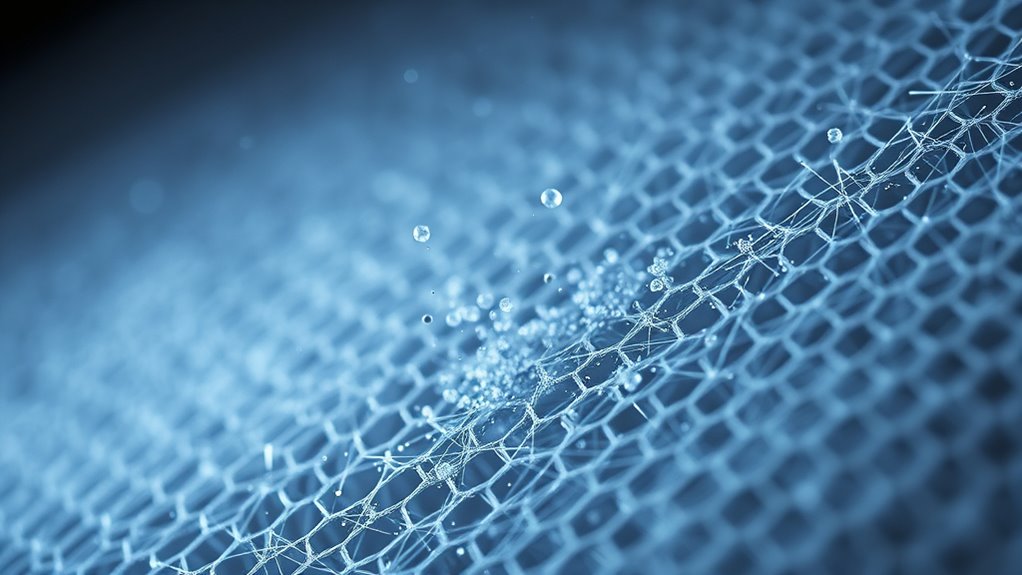
You should know that diffusion, driven by Brownian motion, causes tiny particles to zigzag and collide with filter fibers more often. As particles get smaller, diffusion becomes the main way HEPA filters trap them, especially those under 0.1 microns. This process markedly boosts filtration efficiency against ultrafine particles like viruses and some bacteria. Additionally, Forsale 100 products sometimes include HEPA filters with enhanced diffusion capabilities for better performance. Recognizing how filtration mechanisms work helps in designing more effective air purification systems. The effectiveness of diffusion is also influenced by airflow velocity, which impacts how long particles stay in contact with filter fibers. Understanding filter design principles further enhances the ability to develop filters that maximize particle retention through diffusion.
Brownian Motion Effect
Brownian motion plays a crucial role in enhancing the effectiveness of HEPA filters by causing tiny particles, such as viruses and sub-micron dust, to move unpredictably due to collisions with air molecules. This movement, known as diffusion, makes microscopic particles zigzag, increasing their chances of contact with filter fibers. As particles undergo Brownian motion, their erratic paths boost the likelihood of interception and impaction, especially for ultrafine particles smaller than 0.5 microns. To understand this better: 1. Diffusion causes particles to collide with fibers more often, trapping them effectively. 2. The random movement enhances the capture of ultrafine particles that evade other mechanisms. 3. This process considerably improves HEPA filters’ ability to remove microscopic allergens, including viruses and bacteria. This diffusion process significantly boosts the overall efficiency of air purification. Additionally, the diffusion effect is more pronounced at lower airflow velocities, giving particles more time to move randomly and increasing capture rates. Recognizing that Brownian motion is influenced by particle size and airflow conditions helps in designing more effective filtration systems. Moreover, understanding the airflow dynamics within the filter can optimize the capture of these tiny particles, further enhancing filtration performance.
Particle Size Influence
Particles smaller than 0.3 microns are particularly influenced by diffusion, which causes them to move erratically and collide with filter fibers more frequently. This process is vital for trapping ultrafine particles, including viruses and microscopic pollutants that are too small for traditional sieving. As these particles zigzag due to Brownian motion, their random movement increases contact with filter fibers, boosting capture efficiency. Diffusion becomes the dominant mechanism for particles under 0.3 microns, compensating for their inability to be caught by inertial impaction. Because of this effect, HEPA filters excel at removing a broad range of microscopic pollutants, ensuring cleaner air. Your filter’s ability to trap ultrafine particles relies heavily on diffusion, making it highly effective against tiny airborne contaminants.
Enhanced Filtration Efficiency
Diffusion substantially boosts HEPA filter performance by enabling the capture of ultrafine particles that are too small for traditional mechanisms like sieving or inertial impaction. It causes tiny airborne particles to move randomly, increasing their chances of bumping into filter fibers and getting trapped. This is especially effective for particles around 0.3 microns, which are the most penetrating. Diffusion relies on Brownian motion, making small particles drift and collide repeatedly, improving filtration efficiency.
Key points:
- Diffusion enhances the filter’s ability to trap ultrafine particles, including viruses and pollutants.
- It complements sieving and inertial impaction, especially for the smallest airborne particles.
- Overall, diffusion plays a vital role in maximizing HEPA filters’ ability to remove allergens and improve air quality.
Understanding Particle Sizes and Their Significance in Air Filtration
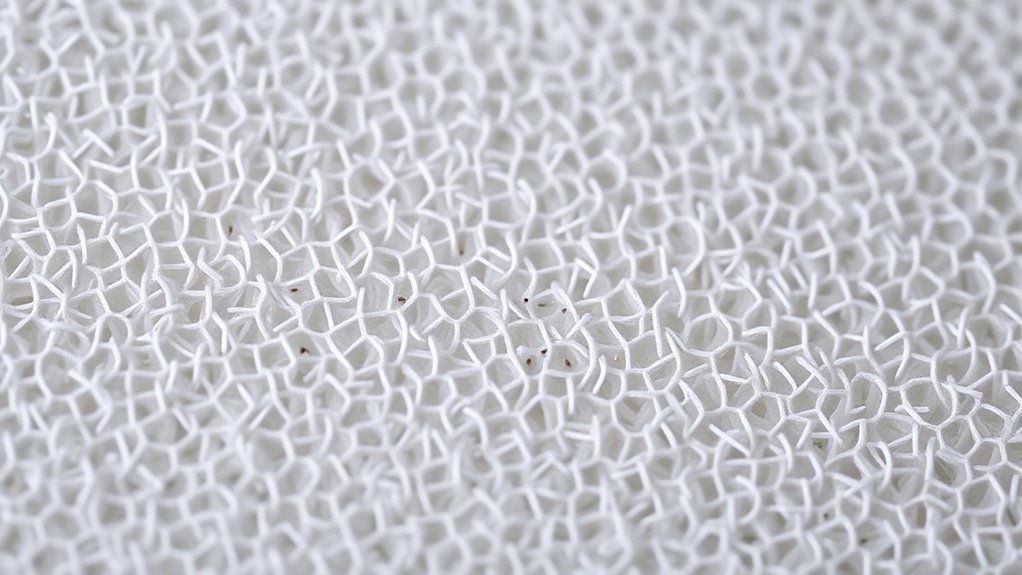
Understanding particle sizes is essential for effective air filtration because it determines how well a filter can capture various airborne pollutants. Different allergens, like pollen (10-100 microns), dust mites (10-25 microns), and pet dander (2-10 microns), vary greatly in size. HEPA filters are designed to trap particles as small as 0.3 microns, which is critical since many allergens fall within or near this range. Particles larger than 0.3 microns are removed through sieving and interception, while smaller particles, such as some viruses, are captured through diffusion. Recognizing the size range of airborne allergens helps you select the right filter for maximum air filtration and filter efficiency, ensuring cleaner, healthier indoor air.
The Multi-Mechanism Approach: Why HEPA Filters Are Highly Effective
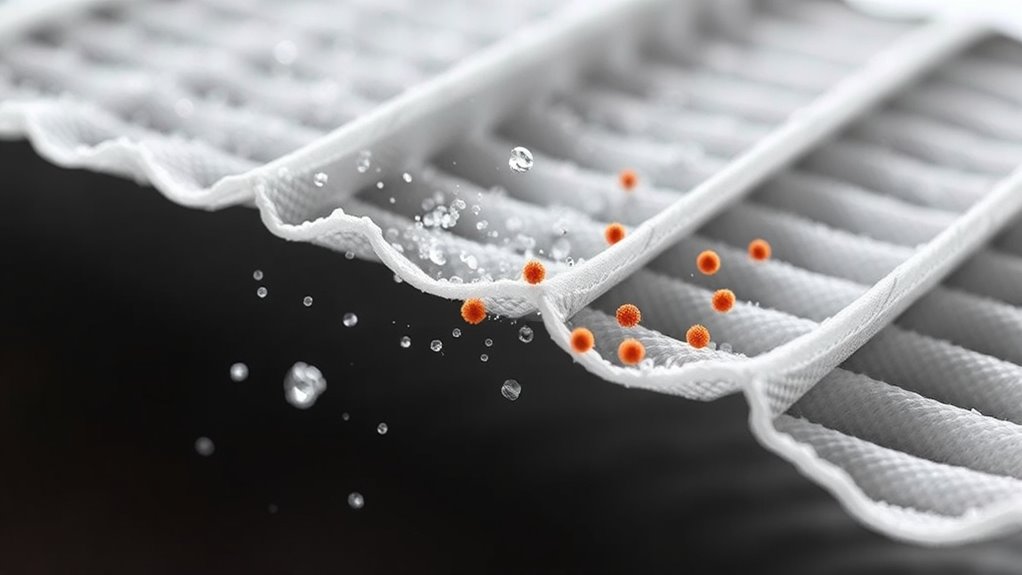
HEPA filters are highly effective because they employ multiple mechanisms to capture a wide range of airborne particles. This multi-mechanism filtration enhances efficiency across various particle sizes, including ultrafine particles. The key mechanisms include sieving, inertial impaction, interception, and diffusion—all working together to maximize removal.
HEPA filters use multiple mechanisms—sieving, impaction, interception, diffusion—to effectively remove various airborne particles.
- Sieving physically blocks larger particles (>10 microns), ensuring they don’t pass through.
- Inertial impaction and interception target mid-sized particles, like pollen and pet dander, by trapping them as they collide with fibers.
- Diffusion is especially effective for ultrafine particles (0.3 to 1 micron), such as viruses, by causing particles to randomly move and collide with filter fibers.
This exhaustive approach makes HEPA filters highly efficient at removing diverse allergens from indoor air.
Comparing Filtration Methods for Different Types of Allergens
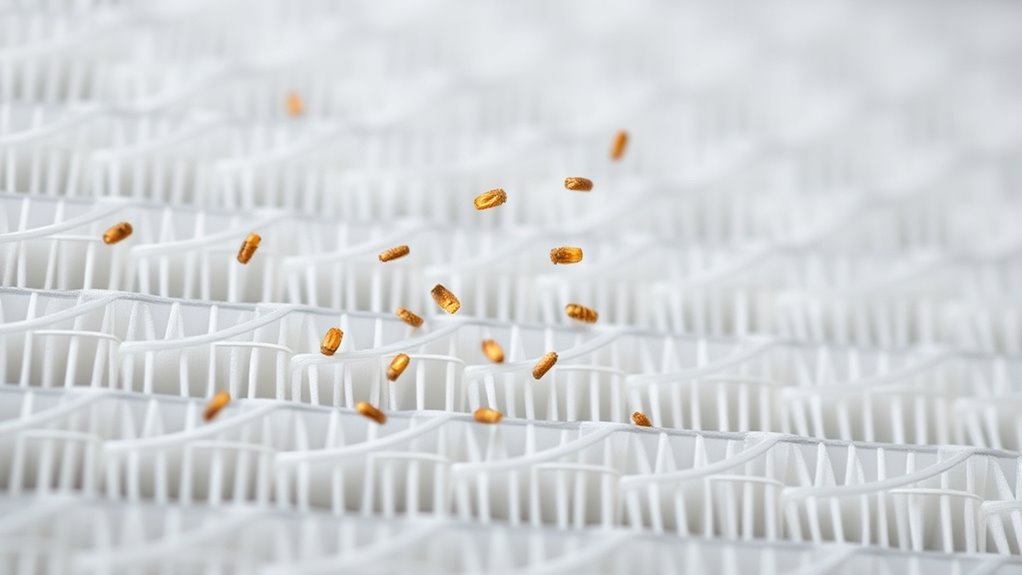
Different allergens vary in size and require distinct filtration mechanisms for effective removal. Filtration methods are tailored to target specific particle sizes, enhancing allergen removal efficiency. Larger particles like pollen (>10 microns) are captured through sieving, physically blocking their passage. Mid-sized particles such as smoke and PM2.5 (1–10 microns) are caught via inertial impaction, which forces them to collide with fibers. Smaller particles, including bacteria (0.3–1 micron), are intercepted as they follow airflow paths. Very tiny particles like viruses (around 0.3 microns or smaller) are removed through diffusion, where Brownian motion causes random collisions with filter fibers. By combining these capture mechanisms, HEPA filters improve indoor air quality, ensuring effective allergen removal across a broad spectrum of particle sizes and maximizing HEPA efficiency.
The Importance of Particle Size: Why 0.3 Microns Is a Key Benchmark
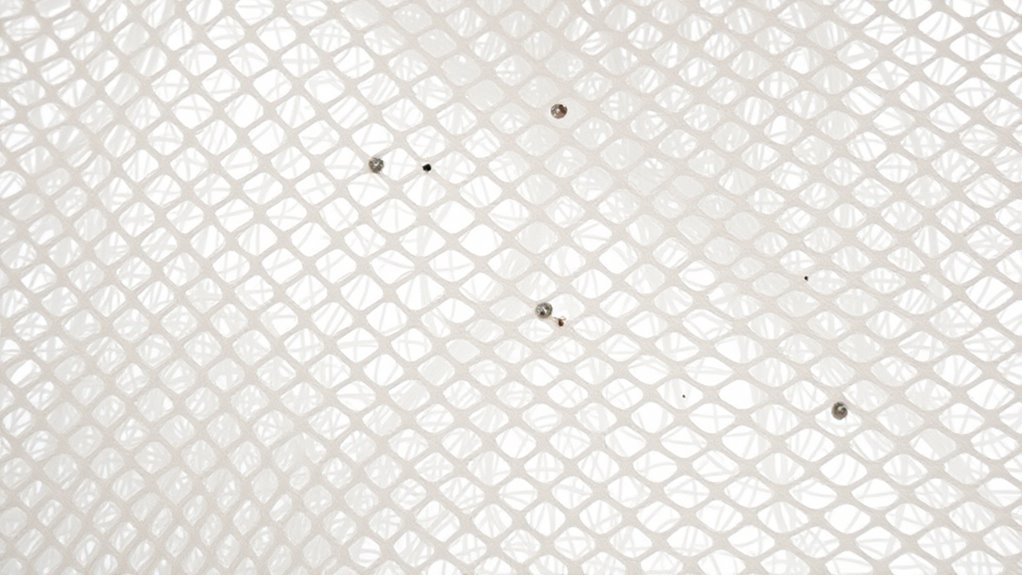
Particles around 0.3 microns pose a unique challenge for filtration because they are the most difficult size for filters to capture effectively. This size, known as the most penetrating particle size (MPPS), tests HEPA filters’ ability to remove airborne contaminants. HEPA filters are designed to block at least 99.97% of particles exactly 0.3 microns, including dust particles, allergens, and some bacteria. Particles smaller than 0.3 microns, like certain viruses, are captured through diffusion, while larger particles are intercepted more easily. Recognizing the significance of this benchmark helps you understand how HEPA filters efficiently target common airborne allergens.
- It highlights the filter’s capability to trap the smallest, most challenging particles.
- It emphasizes the importance of particle size in filter performance.
- It explains why 0.3 microns is a key standard for air purification.
How Material and Design Influence HEPA Filter Performance

The effectiveness of a HEPA filter largely depends on its material composition and design features, which determine how well it captures airborne allergens. Fiber density and fiber orientation play a pivotal role by creating a dense network that traps particles efficiently. The pore size and porosity are engineered to maximize surface area for filtration while maintaining airflow. Material density influences filtration efficiency, with denser materials providing better particle interception. Advanced designs incorporate electrostatic charges, attracting and retaining allergens more effectively without restricting airflow. The fine mesh, typically made of fibers around 0.5 microns in diameter, is optimized to capture tiny particles like pollen and bacteria. Overall, the combination of fiber density, pore size, and electrostatic properties directly impacts the filter’s ability to remove allergens efficiently.
Factors Affecting the Efficiency and Longevity of HEPA Filtration Systems
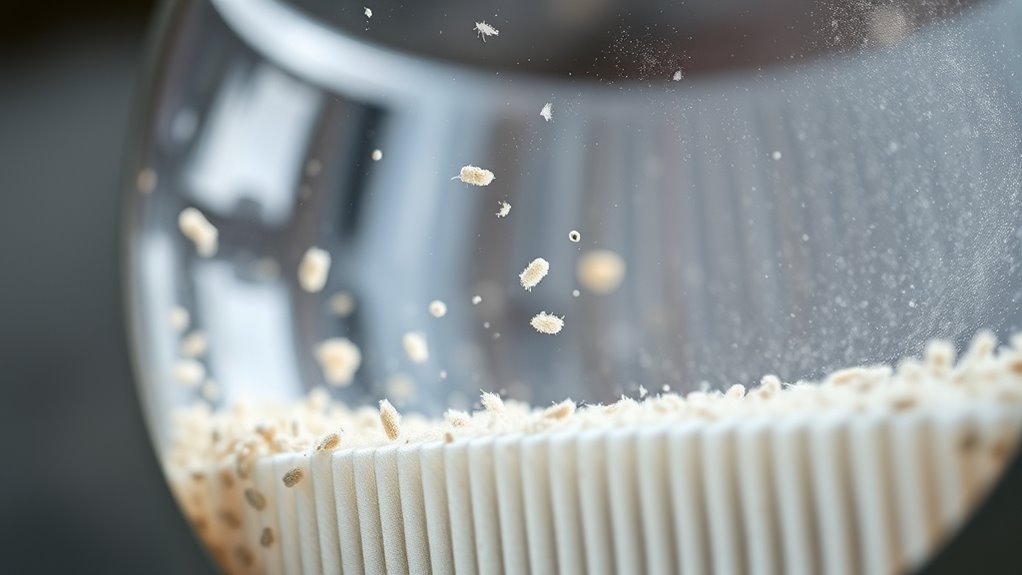
Maintaining the efficiency and lifespan of your HEPA filtration system depends on several key factors. First, the filter lifespan is influenced by how often you replace or clean pre-filters, which keeps airflow resistance low and prevents particle accumulation. Second, air quality plays a role; higher pollutant levels accelerate filter material wear, reducing efficiency. Third, environmental conditions like humidity and temperature fluctuations can weaken filter material, decreasing allergen capture. To optimize performance, consider:
Regular filter replacement and environmental monitoring ensure HEPA system efficiency and longevity.
- Replacing filters regularly to prevent buildup and maintain airflow.
- Ensuring proper installation to reduce airflow resistance.
- Monitoring environmental factors that impact filter durability.
Frequently Asked Questions
Does HEPA Filter Remove Allergens?
You wonder if HEPA filters remove allergens. The answer is yes; they’re highly effective at capturing common indoor allergens like pollen, pet dander, dust mites, and mold spores. They trap over 99.97% of tiny particles as small as 0.3 microns through sieving, impaction, interception, and diffusion. Just remember, they don’t clean allergens hidden in surfaces, so regular cleaning and filter replacements are essential for maintaining a healthier indoor environment.
How Does a HEPA Filter Work?
You want to know how a HEPA filter works, and it does so by trapping airborne particles through four key mechanisms. It sieves large particles, impacts and intercepts medium and small ones, and diffuses the tiniest particles. As air passes through its dense glass fiber mesh, particles collide with fibers and get caught. This process guarantees that even the smallest allergens, like pollen and pet dander, are effectively removed from the air you breathe.
What Do HEPA Filters Not Remove?
You might think HEPA filters remove all airborne particles, but they don’t catch everything. They don’t effectively remove gaseous pollutants like VOCs, odors, or fumes. Tiny particles smaller than 0.3 microns, including some bacteria and viruses, slip through. They also can’t clean allergens embedded in surfaces like carpets or furniture, nor do they eliminate secondary pollutants such as ozone or chemical off-gassing from materials.
What Are the Mechanisms of Filtration of HEPA Filters?
You might think HEPA filters do magic, but they actually use four incredible mechanisms to trap allergens. Sieving blocks large particles like pollen, inertial impaction captures big debris that crash into fibers, interception catches smaller particles by following airflow, and diffusion traps the tiniest ones like viruses through random movement. Together, these processes form a powerful defense, making your air dramatically cleaner and safer to breathe.
Conclusion
Understanding how HEPA filters trap allergens helps you appreciate their effectiveness. For instance, if you run a HEPA-filtered air purifier in your home, it can considerably reduce airborne pollen and pet dander, making allergy seasons more bearable. By choosing the right filter and maintaining it properly, you guarantee cleaner air and better health. Remember, the combination of sieving, diffusion, and interception is what makes HEPA filters a powerful defense against allergens.
